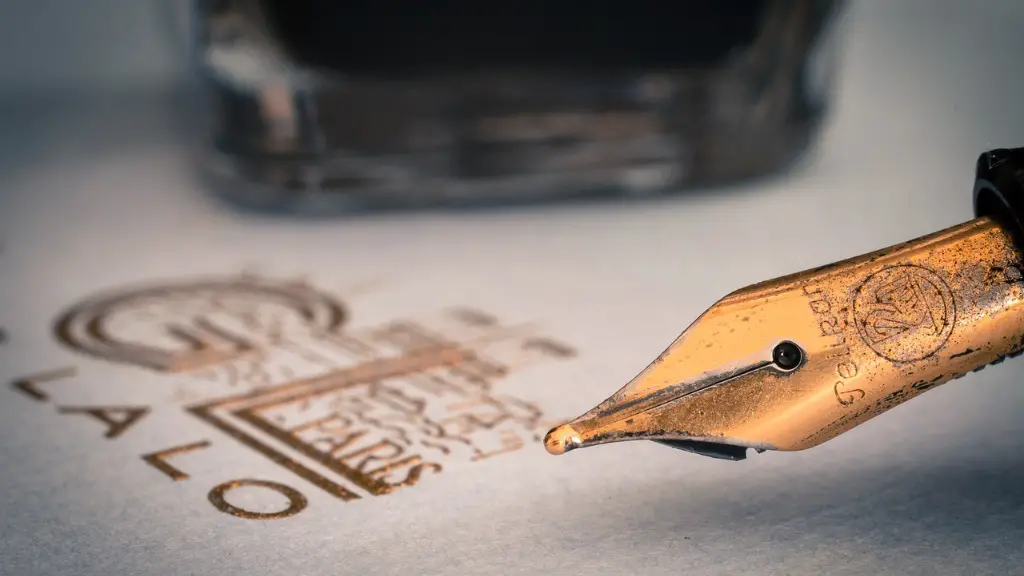Personification is a literary technique used to attribute human characteristics and qualities to non-living things, inanimate objects, animals or abstract ideas such as love, peace or justice. Personification is a common element in poetry, and it allows poets to use figurative language to evoke strong emotions in the reader. Through personification, the writer is able to create a vivid mental picture for the reader and make them feel connected to abstract concepts. Poets use personification to add detail, color and meaning to their writing and to help their readers relate to the characters in their poems.
Personification is used to personalize and give life to things that normally have no life, such as inanimate objects or abstract concepts. It brings the things to life, allowing them to express human attitudes and emotions. Personification gives inanimate objects and animals human qualities, making them more real to the reader. For example, a poet might personify an inanimate object such as a flower by speaking of it as if it had a personality and was capable of feeling: “The flower bowed its head, exhausted by the sun”. This helps create a vivid mental image for the reader and allows the poet to use descriptive words that conjure up emotions.
Personification also allows the poet to write, as if they were actually talking to or about the thing in question. This makes the poem easier to understand and identify with. For example, a poet might write about an abstract concept such as peace, as if it were a person: “Peace came walking slowly, her head down, her hands folded”. This gives peace a human-like quality and allows the reader to connect to the concept. By giving an abstract concept human qualities, the reader is able to see it from a different perspective and can better understand the feeling the poet is trying to convey.
Another use of personification in poetry is to create metaphor. By personifying an object or concept, a poet is able to create a metaphor, which describes one thing in terms of another. For example, a poet might write: “The river was a silver snake, winding its way through the landscape”. This metaphor uses personification to give a vivid description of the river and helps the reader visualize the scene. The imagery created is also more powerful and evokes stronger emotions in the reader.
The most important purpose of personification in poetry is to evoke strong emotions in the reader. By giving an object or concept human characteristics and qualities, the poet is able to make it easier for the reader to relate to and better understand the emotions the poet is trying to express. Personification also helps to create vivid and powerful imagery in the poem, which can help to draw the reader in and keep their attention. Personification is an important tool and can be used to add depth and richness to poetry.
Personification in Mythology
Personification is a literary device that is often used to bring life to inanimate objects and abstract concepts. In mythology, personification is used to great effect and is a common feature in many stories. In Greek mythology, for example, many of the gods and goddesses have qualities that can only be attributed to humans. For example, Zeus is the god of the sky and weather, yet is also portrayed as a jealous and petulant god who is prone to fits of rage. By attributing these human traits to the gods and goddesses, the writer is able to make them relatable and bring them to life for the reader. Personification helps the reader empathize and better understand the characters of the story.
In many myths and legends, personification is used to give abstract concepts or non-living beings superhuman powers and abilities. In Greek mythology, for example, the gods often had powers such as the ability to control the weather or to turn people into animals. In this way, personification can help explain the origins and reasons for certain phenomena, as well as the existence of certain creatures. By making these concepts and creatures more real and human-like, the writer is able to make them relatable to the reader and help them better understand the story.
Personification also helps to bring out the emotions and motivations of the story’s characters. In Greek mythology, for example, many of the gods and goddesses had powerful emotions such as love, rage and envy. By personifying these emotions and attributing them to the gods and goddesses, the writer is able to bring out the human characteristics of the characters and make them more understandable and relateable to the reader. Personification, therefore, allows myths and legends to be more emotionally charged and engaging.
Personification in Poetry
Personification is a commonly used technique in poetry, as poets strive to express their feelings and emotions through the use of language. By personifying non-living things and abstract concepts, poets are able to create vivid mental images and add depth and emotion to their writing. Through the use of personification, poets are able to paint a vivid picture for the reader, one that can evoke strong emotions and make the poem more compelling and engaging.
Personification helps poets to create metaphors and analogies that can help the reader better understand and relate to the poem. For example, a poet might write of a flower as if it were a person: “The flower bowed its head, exhausted by the sun”. This metaphor helps to bring the flower to life and make it more real and relatable to the reader. By personifying the flower, the poet is able to make the reader empathize with it and bring it to life.
Personification also helps poets to create powerful imagery in their writing. By giving non-living things and abstract concepts human qualities and abilities, poets are able to give their writing a greater sense of reality and make the poem more vivid and engaging. By personifying, the poet is also able to evoke strong emotions in the reader, which can help to make the poem more powerful and memorable.
Personification in Other Forms of Literature
Personification is not limited to poetry and can be found in various forms of literature. In novels and short stories, personification is often used to bring characters to life and make them more believable and relatable to the reader. By attributing human characteristics to non-living things and abstract concepts, the writer is able to make the characters more tangible and help the reader understand and empathize with them. Personification can also help create vivid imagery and evoke strong emotions in the reader, making them more engaged.
In plays and screenplays, personification is often used to help create memorable and vivid scenes. By giving human qualities and abilities to inanimate objects, animals and abstract concepts, the writer is able to evoke powerful emotions in the audience and give the scene a greater sense of reality. Personification enables the writer to bring characters and scenes to life and make them more memorable and engaging.
Personification has also been used by many political figures to help explain difficult concepts. By personifying concepts such as justice, freedom and democracy, politicians are able to make them more relatable and tangible to the public, helping to generate support for their ideas and plans. Personification helps to make abstract concepts more real and easier to understand by giving them human qualities and abilities.
The Power of Personification
Personification is an important literary device used to bring inanimate objects, animals and abstract concepts to life and make them more real to the reader. It helps poets to create vivid imagery, evoke strong emotions and make their writing more memorable and engaging. Personification can also be found in other forms of literature and is used to great effect in political rhetoric, helping to make difficult concepts relatable and tangible for the public.
Personification is a powerful and useful literary device that can be used to help create memorable and compelling stories. By giving life to non-living things, animals and abstract concepts, personification enables the writer to evoke strong emotions in the reader, helping to make their writing more vivid and engaging.
Personification in Music
Personification is often used in music to bring life to abstract concepts and give them human qualities. By personifying the subject of a song, the musician is able to create vivid images and make it easier for the listener to relate to and better understand the song. Through personification, the musician is able to evoke powerful emotions in the listener and make the song more memorable and compelling.
Many musicians also use personification to help explain difficult concepts and themes. By personifying concepts such as love, hate and freedom, the musician is able to make them real and tangible to the listener. This helps the listener to understand the themes of the song and connects them to the lyrics, enabling them to empathize with the subject.
Personification also helps the musician to create vivid imagery and create powerful metaphors. By personifying an object or concept, the musician is able to create vivid images and powerful metaphors that can help the listener to better visualize the song’s subject. For example, a musician might personify love as a flower, describing it as a fragile yet beautiful thing: “Love is a delicate flower, blooming in spring”. This imagery helps to bring the concept of love to life for the listener and make it more memorable.
Conclusion
Personification is an important literary device used in poetry, mythology, novels, plays and music. It is used to bring abstract concepts and inanimate objects to life, making them more real and relatable to the reader or listener. By personifying, the writer or musician is able to create vivid imagery that can evoke strong emotions in the reader or listener. Personification can also help explain difficult concepts and themes and make them easier to understand.




